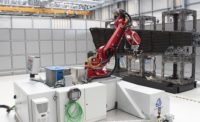Laser tracker technology has advanced by leaps and bounds in the last 20 years. But experts say the biggest shift has actually been in thinking and how they are used.
“What we’ve seen is the change from trackers just being an inspection tool—which they have been for the last several decades—into a manufacturing tool, something that is actually driving the manufacturing process rather than just doing end-of-line quality control,” says Joel Martin, product manager for laser tracker products at Hexagon Manufacturing Intelligence.
That’s not to say the technology is not constantly evolving as well. Laser trackers have come a long way in the last 20 years, from limited inspection tools to the modern products that can interact with a variety of probes, scanners, robotic arms and other tools of automation with great flexibility.
Martin provided the example of a large waterjet machine cutting composite parts. Using a laser tracker, a manufacturer could then use a T-Scan and a T-Mac to inspect the part while it’s still on the machine to verify if it needs be to remanufactured or remilled before it’s unclamped and moved along to the next manufacturing process. The tracker can allow for a closed-loop process, automating the metrology equipment and the cutting machine to coordinate accurately without an operator.
“At its core, what does a laser tracker do? It measures angles and distances,” Martin says. “And when the technology first hit the marketplace, it was all about (inspection). Today it’s changed. So now we’re looking at how we can take primarily large-scale processes—that’s where the tracker comes into its own, on things that are three meters, four meters, five meters, 10 meters, 20 meters, 60 meters. So, large parts, looking at the production process of how those parts are made in manufacturing. And looking at what can we do in the manufacturing process to make this quicker, easier, more repeatable and more robust.”
Solving Problems Before It’s Too Late
It’s one thing if a manufacturer is making small, inexpensive parts like mobile phone cases, and a problem is detected at the end of the line. But a carbon-composite structure for a jet that costs hundreds of thousands of dollars? An in-line tracker could catch a problem before an entire part has to be scrapped.
“So you use the metrology side of what this technology can do and work it into the manufacturing process,” Martin explains. “We’re putting that further upstream, so that as we’re doing the manufacturing … they’re being monitored by the metrology equipment to make sure that when the part is unclamped from that station and moved to the next manufacturing station we already know that it’s good.”
Manufacturers are finding ways to use laser trackers during the manufacturing process beyond in-line and end-of-line inspection, as well.
“We have people who will scan a door opening and scan a door. And the door is custom fit, custom placed on the white body before it’s bolted on so it has a perfect gap all the way around it,” explains Steve Young, Exact Metrology co-president. “There are applications where they are measuring the manufacturing line, so that the line is straight and level all the way through so that you don’t have any racking issues with the fixtures or the tooling that’s building the car.”
Software Advances
Recent software and firmware advances have been especially useful for integrating laser trackers with automated robotic arms and other non-metrology equipment on the factory floor. The new capabilities enable real-time machine control for milling, drilling, grinding, polishing and other processes in a large-scale manufacturing environment. For example, an off-the-shelf six-axis robot could be deployed with a laser tracker and tracker-machine control sensor to precisely measure and correct in real-time the movement of the robot’s end effector for in-place, production operations on the factory floor. The machine control system can be synchronized accordingly and corrections can be applied in real time—even in dynamic robotic setups, according to Hexagon.
Hardware Advances
Steve Young says the tracker hardware itself has become more reliable as the machines have become less analogue and more digital, in a sense.
“There were probably over 100 moving parts inside a tracker, and now you’ve got probably less than 20,” he says. “That’s a significant improvement. It’s gone from gear-driven motors to magnetic drive motors. So you don’t have backlash issues. Before, if you were to grab a laser tracker and try to rotate it manually with your hand, it was a gear-driven motor and the gears locked in. So you couldn’t move it or point it in a certain direction or do anything. So you’d have to go in, disengage the motors and then move it and reengage them. Now it’s all magnetic motors, so you can grab it, and you can turn it and it will catch up to itself and reengage automatically.”
Ease of Use
“Early ‘90s laser trackers almost required a bit of black magic to operate, or at least users convinced their bosses there was some black magic,” Martin says. “It was such a specific art form to make a laser tracker work that laser tracker operators sort of became a class in and of themselves.
“Today, that’s changed dramatically. You look at the trackers we build today and they really are another tool in the toolbox. Tracker technology has advanced substantially. You don’t have to be a laser expert to be able to run these systems. You don’t have to be a metrologist to be able to run these systems. You can take a laser tracker up out of the box, start it up and go out and use it like any other tool in your toolbox, whether that’s a pair of calipers or a height gage to do the inspection task that is at hand.”





